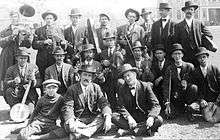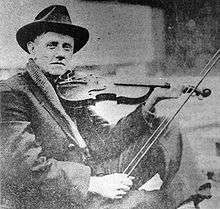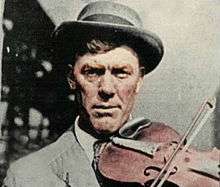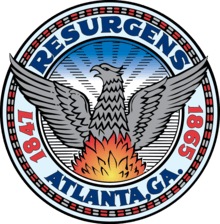Country music in Atlanta
Atlanta played a major role in launching country's earliest recording artists in the early 1920s — many Appalachian people such as Fiddlin' John Carson had come to the city and area to work in its cotton mills and brought their music with them. It would remain a major recording center for two decades and a major performance center for four decades, into the first country music TV shows on local Atlanta stations in the 1950s.[1]

Origins and influences
Much of the audience and many of the artists in Atlanta's country scene lived in the area's three main mill towns: Cabbagetown (Atlanta), a neighborhood in Atlanta itself, Chattahoochee, today within the city's northwestern limits and known as Whittier Mill Village, and Scottdale, just northeast of Decatur.[1]
Atlanta county exhibited influences of Appalachian folk music, black music (notably blues and influences from "Decatur Street" black music scene) and gospel. The first "country blues" recording was likely in 1924, in Atlanta, by Ed Andrews.
Annual Georgia Old-Time Fiddlers' Conventions took place in Atlanta in 1913-1935, a milestone in Atlanta's role as a marketplace for the country genre. Fiddling legend Fiddlin' John Carson placed fourth in the first convention in 1913.[2]
Radio and television
The signal of WSB radio reached far into rural areas and was an important factor in creating country music "stars", similar to the role of WSM in Nashville. WSBs best known country music program was the WSB Barn Dance.
From August 1926 until October 1928, the Sears Agricultural Foundation hosted a radio show, broadcast from the Atlanta Sears tower (now Ponce City Market) called "Dinner Bell R.F.D.". R.F.D. stood for the club "Radio Farmers' Democracy". The show aired on WSB radio between noon and 1 pm three times a week, featuring old-time musicians and string bands[3]
Other than the WSB Barn Dance and a few other exceptions, most of Atlanta's country radio programs stopped broadcasting by the early 1950s; stations broadcast recorded music. Some local country music TV programs were broadcast during the 1950s on WAGA, WLTV, and WSB-TV. Many of the local musicians turned to bluegrass music, started other careers, or pursued their careers in Nashville.[4]
Decline as a center
Gradually, after the 1930s, Nashville became the capital of country music. In addition, Atlanta's aspirations to more "upscale" arts discouraged both the hillbilly band and blues scenes.[5] From the 1940s to the mid-1950s, Atlantans supported a thriving live music scene, but the city no longer was a major center of music recording.[5]
Artists 1920s-1950s
Notable musicians active in the 1920s-1950s Atlanta scene include:
- Fiddlin' John Carson
- Gid Tanner and his Skillet Lickers
- John Dilleshaw
- Bud Landress
- Georgia Yellow Hammers
- Bill Chitwood
- Charles E. Moody
- Charles Mitchell (songwriter)
- Earl Johnson (fiddler)
- Phil Reeve
- Jimmie Rodgers who recorded "Waiting for a Train" in Atlanta in 1928
- Andrew and Jim Baxter
- Bill Lowery
- Robert Morland Stanley
Later and current artists
Later country artists active in Atlanta included Jerry Reed and Kenny Rogers. Today, Metro Atlanta is home to Alan Jackson, Jason Aldean, Zac Brown Band, Sugarland, Ray Stevens and Travis Tritt.
References
- Wayne W. Daniel, Pickin' on Peachtree: a History of Country Music in Atlanta, Georgia
- "Georgia Old-Time Fiddlers' Conventions", New Georgia Encyclopedia
- Jerry R. Hancock, Jr., Dixie Progress: Sears, Roebuck & Co. and How it became an Icon in Southern Culture, Georgia State University
- GSU Library, Popular Music and Culture Collection Archived 2012-02-25 at the Wayback Machine
- "Atlanta: City Without a Sound?", Footnotes (Journal of the American Sociological Association), May/June 2003


